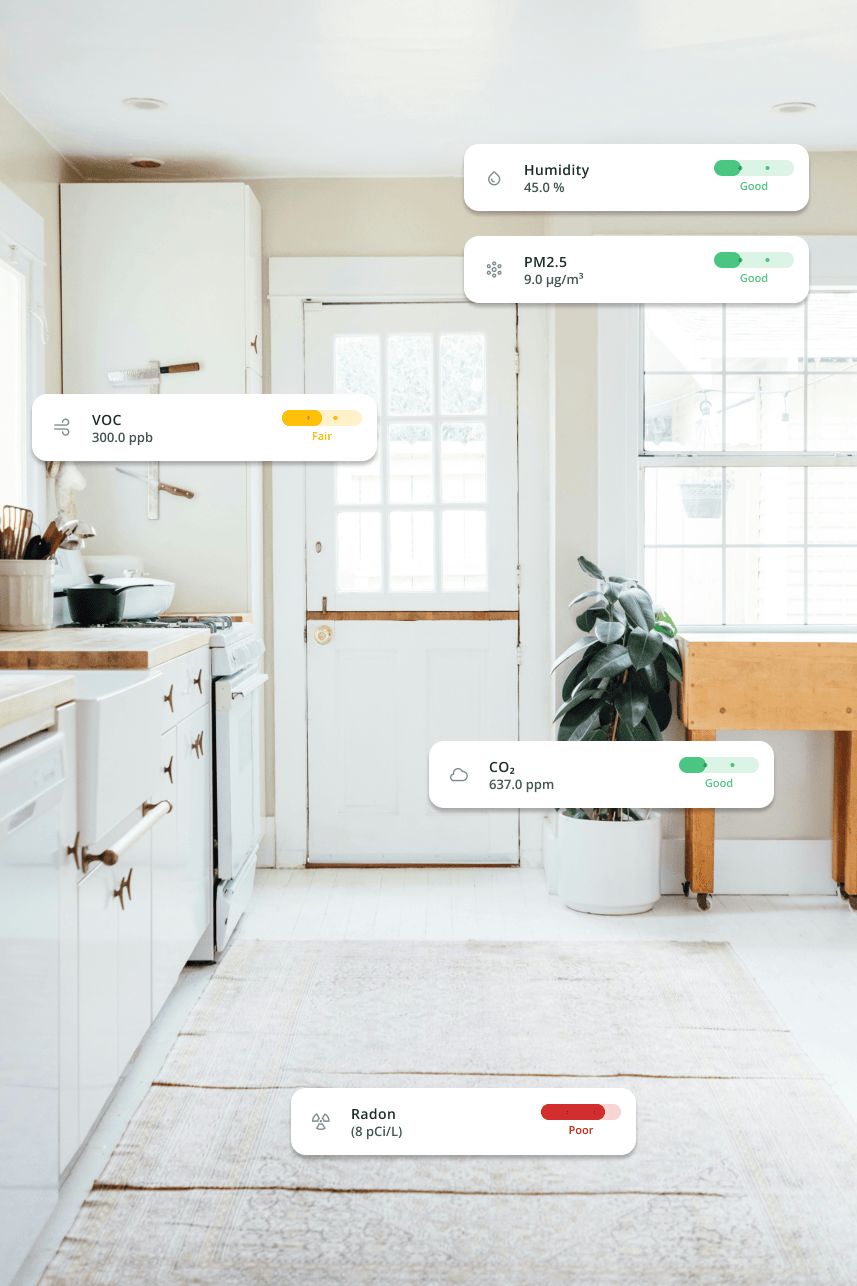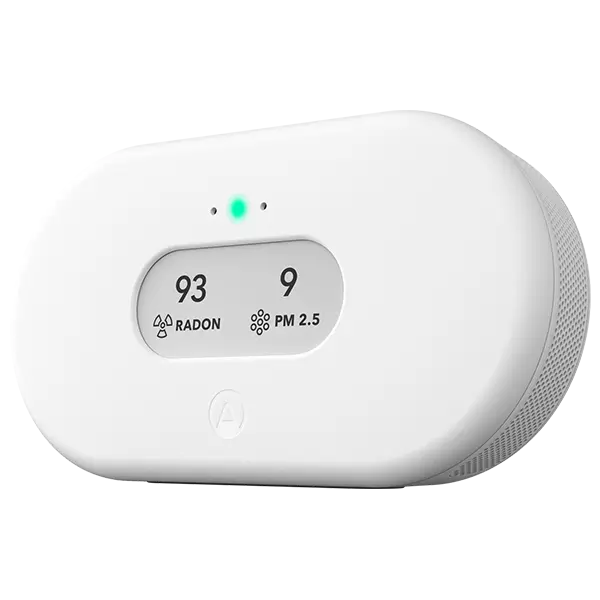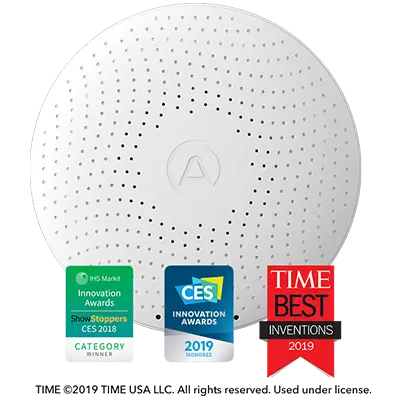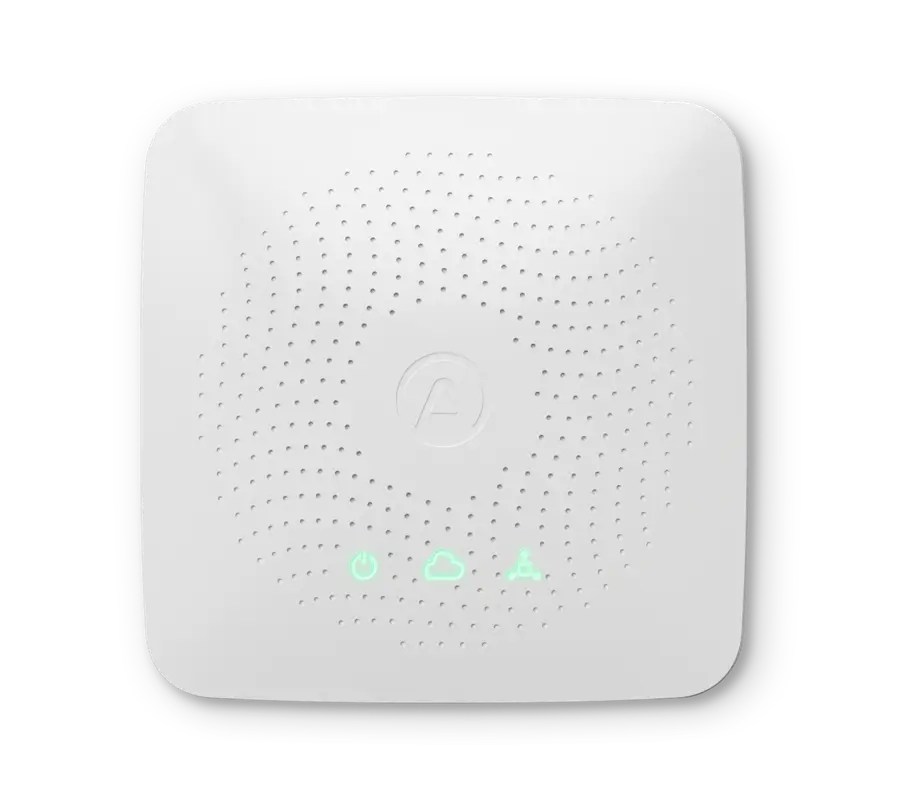Steps to testing air quality at home
1. Choose the right tool
Selecting the right indoor quality monitor depends on your monitoring needs, room types, and connectivity preferences.
Choose a monitor that detects the specific pollutants that concern you. For example, if you live in an area with high outdoor air pollution, you’re more likely to need a model that detects particulate matter (PM).
Radon issues can occur in both older homes and newly constructed ones, and especially in basements, so it’s important to test for radon regardless of your home’s age. The Environmental Protection Agency (EPA) suggests testing for radon every two years, but because radon levels can fluctuate due to weather, soil conditions, and changes in ventilation, we recommend continuous monitoring with a radon detector for the best overview of radon levels.
For continuous and comprehensive monitoring, Airthings View Plus is ideal and offers detailed insights into pollutants like CO2, VOCs, PM2.5, and radon in the app for real-time data and trend analysis. It’s perfect for living areas, kitchens and bedrooms where a broad view of air quality is beneficial.
In specific rooms:
- Bathrooms, laundry rooms and garages benefit from Wave Mini, which focuses on humidity and VOCs to help prevent mold and maintain comfort.
- Basements can use View Radon or Corentium Home for insights into radon, ensuring a healthy environment in these crucial areas.
2. Analyze results
Review the data from your air quality monitor. Look for elevated levels of pollutants and identify any patterns or sources of poor air quality. Note that while PM2.5, temperature, air pressure, and humidity readings for Airthings monitors are calibrated out-of-the-box, the VOC, CO2, and radon sensors require additional time to calibrate. Specifically, Airthings monitors’ VOC and CO2 sensors need about a week to fully calibrate. Radon sensors, however, will require up to 30 days for complete calibration. Therefore, ensure you consider this calibration period when analyzing initial data to obtain accurate and reliable results.
3. Maintain your equipment
Regularly maintain your air quality monitors to ensure they provide accurate readings. This includes changing out batteries, checking if the device is still connected to the app, and ensuring the sensors are functioning properly. Regular maintenance will help you continue to monitor indoor air effectively and take timely actions when needed.
4. Take action based on results
Once you have gathered data from your monitors, the next step is to take actionable measures to improve your indoor environment. Here’s how you can effectively respond to the information provided by your monitors:
Improve ventilation: If your sensor data shows elevated levels of pollutants like CO2 or VOCs, improving ventilation is essential. Open windows and use exhaust fans to increase airflow and dilute indoor contaminants.
Use air purifiers: For areas where specific pollutants are consistently high, air purifiers can be a valuable addition. Choose purifiers with appropriate filters for the pollutants you need to address. For example, the Airthings Renew purifier has a HEPA filter that is effective for particulate matter, while the activated carbon filters help reduce VOCs and odors.
Adjust humidity levels: Use a dehumidifier or humidifier as needed to maintain optimal humidity levels to prevent mold growth or increase comfort.
Regular maintenance: Keep track of your air quality trends and perform regular maintenance based on the data. This includes cleaning air ducts, replacing air filters, and checking for mold or moisture issues. Regular upkeep helps prevent the buildup of pollutants and maintains optimal air quality.
5. If all else fails, seek professional help
While an indoor air quality monitor can provide useful insights and inform action for improving your home’s air, for example showing you that it might be time to open a window or turn up your ventilation system, there are times where professional advice and/or services might be necessary. For example, if you observe high radon levels over extended periods, it's advisable to consult a radon mitigation professional. There are DIY fixes that can help, for example sealing cracks in foundations or around windows, however if elevated radon is observed over several months and DIY fixes don't help, then a radon mitigation system may be needed.
Frequently Asked Questions
How do indoor air quality monitors work?
Indoor air quality monitors use a range of sensors to track various pollutants in your home. These sensors detect and measure levels of pollutants such as particulate matter (PM2.5), volatile organic compounds (VOCs), carbon dioxide (CO2), and radon. Airthings monitors collect this data continuously and display it in real-time through an app or on the device itself, allowing you to see the air quality trends and make informed decisions to improve your indoor environment.
Where should I place my air quality monitor for the best results?
For the most relevant insights, place your air quality monitor in the area where you spend the majority of your time. This ensures that you’re getting an accurate picture of the air quality where you breathe most frequently. Position it at breathing height on a solid surface, avoid excessively humid areas, and keep it in a spot where it’s less likely to be moved or tampered with. If the monitor has a waving feature, such as Airthings View Plus or Wave Plus, make sure it’s within about 25 cm (10 inches) of your reach for best performance. Learn more about correct placement here.
How can I tell if my air quality monitor is working correctly?
To confirm that your air quality monitor is functioning correctly, check the calibration status as per the manufacturer's instructions and care for the product as needed. Regular updates to the device’s firmware and app can also help ensure it provides accurate data. If you notice any discrepancies or issues, it might be worth contacting customer support for guidance.
Choosing a brand you trust is crucial for ensuring reliable performance and peace of mind. At Airthings, we stand behind our products’ quality, offering both top-notch technology and dedicated customer support to help you maintain optimal air quality in your environment.
What are the limitations of home air quality monitors?
Indoor air quality monitors can have some limitations. They might not detect all types of pollutants, especially those present in very low concentrations. Their accuracy can also vary between models, and some sensors may need regular calibration to stay accurate. For instance, radon and VOC sensors might require several days or weeks to provide stable readings.
How should I interpret fluctuations in air quality data?
Fluctuations in air quality data can be caused by various factors, such as changes in ventilation, recent home activities, or external environmental conditions. To understand these fluctuations, look at the trends over time rather than focusing on isolated spikes. Consider recent events or changes that might have impacted air quality and address any recurring issues.
Can indoor plants help with air quality?
While indoor plants can add a touch of nature to your home, their impact on air quality is very limited. Most studies show that their ability to filter out pollutants is minimal compared to air purifiers and proper ventilation. They do contribute to a pleasant environment and may improve your mood, but they shouldn’t be relied upon as the primary solution for indoor air issues.
Do air quality monitors detect pollutants that come from outside?
Yes, air quality monitors can detect outdoor pollutants that enter your home. For example, models like Airthings View Plus can measure particulate matter (PM2.5) and other pollutants from outside sources, such as traffic or nearby industrial activities, that come in through open windows or vents. These insights help you identify and address external pollution sources to improve your indoor air.















%20(1).webp)

%20(1).webp)
